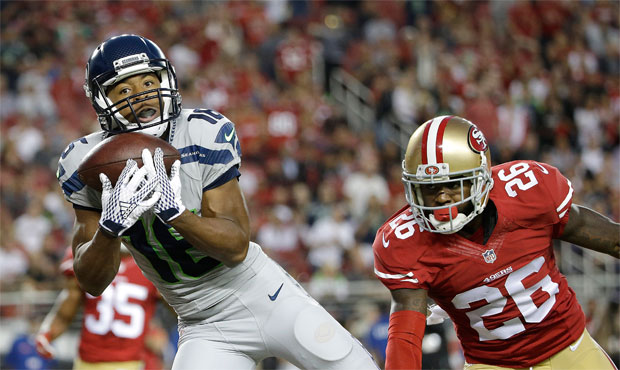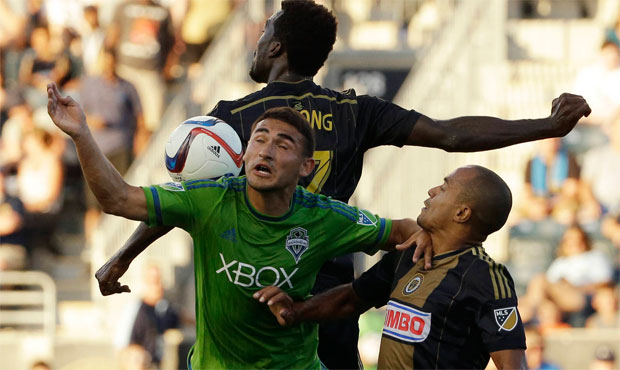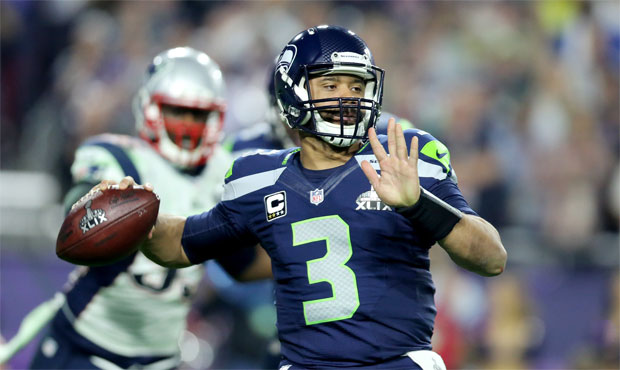Brady Henderson
Measuring Marshawn Lynch’s legacy, impact with the Seahawks
 Marshawn Lynch averaged more than 1,600 combined rushing and receiving yards from 2011 to 2014. (AP)
Marshawn Lynch averaged more than 1,600 combined rushing and receiving yards from 2011 to 2014. (AP)
It was surprising when Marshawn Lynch sent out a cryptic tweet during the fourth quarter of the Super Bowl on Sunday, posting a picture of neon green cleats hung up and an emoji of two fingers forming a V as if to say, “Peace out.”
At the same time, it was completely fitting based on everything we learned about Lynch during his six seasons with the Seahawks.
Related: Seahawks thank Marshawn Lynch with video tribute
Having battled with the NFL over league rules requiring players to speak with the media, the laconic superstar declared his intention to retire without saying a single word. Having shunned the spotlight for the latter portion of his career, Lynch decided to break his own news on the one day when the sports world’s attention wouldn’t budge from something else. And having done things his own way, on his own terms, Lynch made his announcement apparently without first informing the team, with which his relationship had deteriorated in recent years.
Here are some additional thoughts on Lynch’s retirement, which is all but official with confirmation from his agent, Doug Hendrickson:
Lynch’s impact. He was a catalyst not just for an offense that centered around his rugged running style but also for the franchise’s turnaround, which began after his arrival from Buffalo during the 2010 season. General manager John Schneider had been trying to acquire Lynch for some time. He and coach Pete Carroll identified Lynch as the runner around whom they wanted to build Seattle’s offense, not just because of his talent but also because they felt his relentlessness could set the desired tone. Lynch averaged more than 1,600 combined rushing and receiving yards and more than 13 touchdowns from 2011 to 2014, before an assortment of injuries limited him to seven regular-season games last season. And none of that counts what Lynch did in the postseason (more on that below). Lynch was more than the Seahawks’ star running back during that stretch, even in his first season with Seattle. He was their identity. Seattle, by the way, gave up a 2011 fourth-round pick and what turned out to be a fifth-round pick the next year to get Lynch. That was a minimal investment for what became a huge return.
Hall of Fame? Here’s a story from last year examining Lynch’s credentials for the Pro Football Hall of Fame. John Clayton, who has a hall-of-fame vote, said at the time that he thought another Lynch-like season would put him in better position and that two of them would secure his spot in Canton. Lynch rushed for only 417 yards and three touchdowns in 2015, bringing his career totals to 9,112 and 74. For context, those numbers are similar to what hall-of-fame running back Earl Campbell produced during his career, which lasted one fewer season than Lynch’s. Campbell totaled 9,407 rushing yards and also scored 74 touchdowns. Lynch more than doubled his receiving production while their yards-per-carry averages are about the same. Something hall-of-fame voters will consider is Lynch’s stellar postseason production. According to ESPN Stats & Information, Lynch is eighth in NFL history with 937 rushing yards in the playoffs. He topped 100 yards rushing in six (of his 11) postseason games, second-most in league history. Also mentioned in that story linked above is the possibility that some hall-of-fame voters factor into their decision Lynch’s rocky relationship with the media. As Clayton noted, that isn’t supposed to be a consideration but could be.
Lynch the teammate. The outpouring of messages from Lynch’s teammates illustrate how revered he is among his peers. Producing the way Lynch did when he was at his best goes a long way in an NFL locker room. But it was more than what Lynch did on the field that earned his teammates’ respect. Several of them have called him the best teammate they’ve ever played with. And while he didn’t always see eye-to-eye with Seattle’s coaches or the team’s management, one story involving an assistant showed another side of Lynch. During a one-on-one interview the week before Super Bowl XLVIII, Lynch’s position coach, Sherman Smith, recalled what happened when the father of Seahawks linebackers coach Ken Norton, Jr. passed away in September of 2013. Lynch requested permission to skip a team meeting so that he could drive to the airport and offer his condolences in-person before Norton flew home.
Cap ramifications. Lynch’s retirement will clear $6.5 million in cap space for 2016. That total is Lynch’s $11.5 million cap charge minus the $5 million in remaining signing-bonus proration that Seattle has to eat. The $6.5 million cap savings for 2016 is the same as if the Seahawks were to have released Lynch, which they likely would have done had he not retired. The difference in those two outcomes – as is noted in this story from two weeks ago – is that the Seahawks can technically recoup from Lynch the $5 million in bonus money, which is recourse the team wouldn’t have had it released Lynch. The key word there is “can” recoup. It’s an option that teams have with players who retire before their contracts expire. While collecting some or all of that money could give the Seahawks additional cap relief in 2017 and/or 2018, they’re not required to do so. Perhaps there is an agreement that they won’t. That’s entirely possible considering Lynch could have waited for the Seahawks to release him if he was worried about the team coming after that $5 million.

























Comments